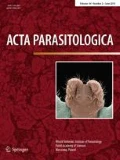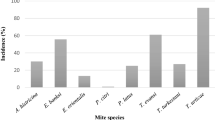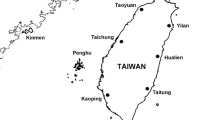Abstract
Purpose
The study of the Red Palm Weevil (RPW), Rhynchophorus ferrugineus (Olivier), as an invasive pest of palm trees.
Methods
In this study, 36 RPW individuals were collected from 6 different locations in Egypt. The presences of endosymbionts in the RPW individuals were assayed. The phylogenetic analysis of the RPW inhabiting Egypt was conducted using Cytochrome c oxidase sub-unit 1 (CO1) gene.
Results
Spiroplasma was found, for the first time, in all individuals, while Rickettsia was found, for the first time, in individuals collected from only 3 of the 6 locations. Endosymbionts harbouring Egyptian RPW were closely related to those harbouring Diptera and\or Trombidiformes associated with palm trees. This may be due to horizontal transmission through palm sap or through ectoparasites living on the RPW. Finally, the phylogenetic analysis of the RPW inhabiting Egypt was conducted. The collected individuals were closely related to Saudi Arabia specimens collected from the eastern region. Thus, Saudi Arabia may be the origin of the RPW which invaded Egypt. Individuals from populations inhabiting the same geographical locations were closely related. This may be due to secondary invasion incidents that may have taken place through transportation of infested date palm trees and offshoots from infected to uninfected locations.
Conclusion
This study reports the first incidence for the presence and coexistence of Spiroplasma and Rickettsia in RPW collected from Egypt. In addition, it was found that the collected individuals of RPW were closely related to a Saudi haplotype. Thus, Saudi Arabia may be the origin of infection which invaded Egypt.




Similar content being viewed by others
Availability of data and material
All data generated or analyzed during this study are included in this published article [and its supplementary information files].
References
FAOSTAT (2010) Agricultural Database of the Food and Agriculture Organization of the United Nations. In: Italy: Rome, Italy: Food and Agriculture Organisation Rome. www.faostat.fao.org
FAO (2019) Data for Crop Production in 2017. http://www.fao.org/faostat/en/#data. Accessed 25 Jan 2019
FAOSTAT (2013) Food and Agricultural Commodities Production. http://www.faostat3.fao.org/download/Q/QC/E. Accessed 23 Oct 2015
Chornesky EA, Bartuska AM, Aplet GH, Britton KO, Cummings-Carlson J, Davis FW, Eskow J, Gordon DR, Gottschalk KW, Haack RA, Hansen AJ, Mack RN, Rahel FJ, Shannon MA, Wainger LA, Wigley BAT (2005) Science priorities for reducing the threat of invasive species to sustainable forestry. Bioscience 55(4):335–348. https://doi.org/10.1641/0006-568(2005)055[0335:SPFRTT]2.0.CO;2
Aukema JE, Leung B, Kovacs K, Chivers C, Britton KO, Englin J, Frankel SJ, Haight RG, Holmes TP, Liebhold AM, McCullough DG, Holle BV (2011) Economic impacts of non-native forest insects in the continental United States. PLoS ONE 6(9):1–7. https://doi.org/10.1371/journal.pone.0024587
Cox M (1993) Red palm weevil, Rhynchophorus ferrugineus, in Egypt. FAO Plant Protect Bull 41(1):30–31
Ferry M, Gomez S (2002) The red palm weevil in the Mediterranean area. Palms 46(4):172–178. http://www.palms.org/palmsjournal/2002/redweevil.htm
El-Mergawy RA, Faure N, Nasr MI, Avand-Faghih A, Rochat D, Silvain JF (2011a) Mitochondrial genetic variation and invasion history of red palm weevil, Rhynchophorus ferrugineus (Coleoptera: Curculionidae), in Middle-East and Mediterranean Basin. Int J Agric Biol 13:631–637. https://hal.archives-ouvertes.fr/hal-01019352
El-Mergawy RA, Al Ajlan AM, Abdallah NA, Nasr MI, Silvain JF (2011) Determination of different geographical populations of Rhynchophorus ferrugineus (Olivier)(Coleoptera: Curculionidae) using RAPD-PCR. Int J Agric Biol 13:227–232
Giblin-Davis RM, Faleiro JR, Jacas JA, Peña JE, Vidyasagar P (2013) Biology and management of the red palm weevil, Rhynchophorus ferrugineus. In: Potential invasive pests of agricultural crops (eds Peña JE), pp 1–34
Kaakeh W, Khamis A, Aboul-Nour MM (2001) The red palm Weevil: the most dangerous agricultural pest. UAE University Press, Abu Dhabi, p 163
Abraham V, Shuaibi MA, Faleiro J, Abozuhairah R, Vidyasagar PS (1998) An integrated management approach for red palm weevil Rhynchophorus ferrugineus Oliv. a key pest of date palm in the Middle East. JAMS 3(1):77–83. https://doi.org/10.24200/jams.vol3iss1pp77-83
Faleiro J (2006) A review of the issues and management of the red palm weevil Rhynchophorus ferrugineus (Coleoptera: Rhynchophoridae) in coconut and date palm during the last one hundred years. Int J Trop Insect Sci 26(3):135–154. https://doi.org/10.1079/IJT2006113
Eleftherianos I, Atri J, Accetta J, Castillo J (2013) Endosymbiotic bacteria in insects: guardians of the immune system? Front Physiol 4:46. https://doi.org/10.3389/fphys.2013.00046
Ali H, Muhammad A, Hou Y (2018) Absence of Wolbachia in red palm weevil, Rynchophorus ferrugineus Olivier (Coleoptera: Curculionidae): a PCR-based approach. Appl Ecol Environ Res 16:1819–1833. https://doi.org/10.15666/aeer/1602_18191833
Lachowska D, Kajtoch L, Knutelski S (2010) Occurrence of Wolbachia in central European weevils: correlations with host systematics, ecology, and biology. Entomol Exp Appl 135:105–118. https://doi.org/10.1111/j.1570-7458.2010.00974.x
Werren JH, Baldo L, Clark ME (2008) Wolbachia: master manipulators of invertebrate biology. Nat Rev Microbiol 6(10):741–751. https://doi.org/10.1038/nrmicro1969
Alphey L, McKemey A, Nimmo D, Oviedo MN, Lacroix R, Matzen K, Beech C (2013) Genetic control of Aedes mosquitoes. Pathog Glob Health 107(4):170–179. https://doi.org/10.1179/2047773213Y.0000000095
Xi Z, Khoo CC, Dobson SL (2005) Wolbachia establishment and invasion in an Aedes aegypti laboratory population. Science 14:326–328. https://doi.org/10.1126/science.1117607
Iturbe-Ormaetxe I, WalkerO’Neill TSL (2011) Wolbachia and the biological control of mosquito-borne disease. EMBO Rep 12(6):508–518. https://doi.org/10.1038/embor.2011.84
Wattanapongsiri A (1966) A revision of the genera Rhynchophorus and Dynamis (Coleoptera: Curculionidae). Sci Bull Dept Agric Thailand 1:328
Mahmud AI, Farminhao J, Viez ER (2015) Red palm weevil (Rhynchophorus ferrugineus Olivier, 1790): threat of palms. J Biol Sci 15(2):56–67. https://doi.org/10.3923/jbs.2015.56.67
Helmi A, Sharaf A (2016) Genetic differentiating Aphis fabae and Aphis craccivora (Hemiptera: Sternorranycha: Aphididae) populations in Egypt using mitochondrial COI. Biologia 71(11):1266–1273. https://doi.org/10.1515/biolog-2016-0151
Sambrook J, Russell DW (2001) Molecular cloning: a laboratory manual, vol 1. Cold Spring Harbor Laboratory Press, Cold Spring Harbor
Sanger F, Nicklen S, Coulson AR (1977) DNA sequencing with chain-terminating inhibitors. Proc Natl Acad Sci USA 74(12):5463–5467
Johnson M, Zaretskaya I, Raytselis Y, Merezhuk Y, McGinnis S, Madden TL (2008) NCBI BLAST: a better web interface. Nucleic Acids Res 36(2):5–9. https://doi.org/10.1093/nar/gkn201
Katoh K, Standley DM (2013) MAFFT multiple sequence alignment software version 7: improvements in performance and usability. Mol Biol Evol 30(4):772–780. https://doi.org/10.1093/molbev/mst010
Darriba D, Taboada GL, Doallo R, Posada D (2011) ProtTest-HPC: Fast selection of best-fit models of protein evolution. Lect Notes Comput Sci (including Subser Lect Notes Artif Intell Lect Notes Bioinformatics) 6586:177–184. https://doi.org/10.1007/978-3-642-21878-1_22
Stamatakis A (2014) RAxML version 8: a tool for phylogenetic analysis and post-analysis of large phylogenies. Bioinformatics 30(9):1312–1313. https://doi.org/10.1093/bioinformatics/btu033
Lartillot N, Philippe HA (2004) Bayesian mixture model for across-site heterogeneities in the amino-acid replacement process. Mol Biol Evol 21(6):1095–1109. https://doi.org/10.1093/molbev/msh112
Librado P, Rozas J (2009) DnaSP v5: a software for comprehensive analysis of DNA polymorphism data. Bioinformatics 25:1451–1452. https://doi.org/10.1093/bioinformatics/btp187
Bandelt HJ, Forster P, Röhl A (1999) Median-joining networks for inferring intraspecific phylogenies. Mol Biol Evol 16(1):37–48. https://doi.org/10.1093/oxfordjournals.molbev.a026036
Shannon P, Markiel A, Ozier O, Baliga NS, Wang JT, Ramage D, Amin N, Schwikowski B, Ideker T (2003) Cytoscape: a software environment for integrated models of biomolecular interaction networks. Genome Res 13(11):2498–2504. https://doi.org/10.1101/gr.1239303
Ota T, Kawabe M, Oishi K, Poulson D (1979) Non-male-killing spiroplasmas in Drosophila hydei. J Hered 70(3):211–213. https://doi.org/10.1093/oxfordjournals.jhered.a109235
Kageyama D, Anbutsu H, Watada M, Hosokawa T, Shimada M, Fukatsu T (2006) Prevalence of a non-male-killing spiroplasma in natural populations of Drosophila hydei. Appl Environ Microbiol 72(10):6667–6673. https://doi.org/10.1128/AEM.00803-06
Mateos M, Castrezana SJ, Nankivell BJ, Estes AM, Markow TA, Moran NA (2006) Heritable endosymbionts of Drosophila. Genetics 174(1):363–376. https://doi.org/10.1534/genetics.106.058818
Haselkorn TS, Markow TA, Moran NA (2009) Multiple introductions of the Spiroplasma bacterial endosymbiont into Drosophila. Mol Ecol 18:1294–1305. https://doi.org/10.1111/j.1365-294X.2009.04085.x
Watts T, Haselkorn TS, Moran NA, Markow TA (2009) Variable incidence of Spiroplasma infections in natural populations of Drosophila species. PLoS ONE 4:5. https://doi.org/10.1371/journal.pone.0005703
Jaenike J, Stahlhut JK, Boelio LM, Unckless RL (2010) Association between Wolbachia and Spiroplasma within Drosophila neotestacea: an emerging symbiotic mutualism? Mol Ecol 19(2):414–425. https://doi.org/10.1111/j.1365-294X.2009.04448.x
Weinert LA, Werren JH, Aebi A, Stone GN, Jiggins FM (2009) Evolution and diversity of Rickettsia bacteria. BMC Biol 7(1):6. https://doi.org/10.1186/1741-7007-7-6
Weinert LA, Araujo-Jnr EV, Ahmed MZ (1807) Welch, JJ (2015) The incidence of bacterial endosymbionts in terrestrial arthropods. Proc R Soc B 282:20150249. https://doi.org/10.1098/rspb.2015.0249
Malloch JR (1917) A preliminary classification of Diptera, exclusive of Pupipara, based upon larval and pupal characters, with keys to imagines in certain families. Bull Ill Nat Hist Surv 12:03. http://hdl.handle.net/2142/46388
Sato M (1991) Comparative morphology of the mouthparts of the family Dolichopodidae (Diptera). Insecta Matsumurana 45:49–75. http://hdl.handle.net/2115/9860
Downes J, Smith S (1969) New or little known feeding habits in Empididae (Diptera). CAN Entomol 101(4):404–408. https://doi.org/10.4039/Ent101404-4
Grimaldi D (1999) The co-radiations of pollinating insects and angiosperms in the Cretaceous. Ann Mo Bot Gard 86:373–406. https://doi.org/10.2307/2666181
Quattrocchi U (2017) CRC world dictionary of palms: common names, scientific names, eponyms, synonyms, and etymology (2 Volume Set): CRC Press: Boca Raton, FL, USA, ISBN 9788578110796
Gerlach J (2003) Pollination in the coco-de-mer. Lodoicea Maldivica Palms 47(3):135–138
Zhang YK, Chen YT, Yang K, Qiao GX, Hong XY (2016) Screening of spider mites (Acari: Tetranychidae) for reproductive endosymbionts reveals links between co-infection and evolutionary history. Sci Rep 6(1):1–9. https://doi.org/10.1038/srep27900
Martin OY, Puniamoorthy N, Gubler A, Wimmer C, Bernasconi MV (2013) Infections with Wolbachia, Spiroplasma, and Rickettsia in the Dolichopodidae and other Empidoidea. Infect Genet Evol 13:317–330. https://doi.org/10.1016/j.meegid.2012.11.005
Goodacre SL, Martin OY (2012) Modification of insect and arachnid behaviours by vertically transmitted endosymbionts: infections as drivers of behavioural change and evolutionary novelty. Insects 3(1):246–261. https://doi.org/10.3390/insects3010246
Xie J, Vilchez I, Mateos M (2010) Spiroplasma bacteria enhance survival of Drosophila hydei attacked by the parasitic wasp Leptopilina heterotoma. PLoS ONE 5:8. https://doi.org/10.1371/journal.pone.0012149
Brumin M, Kontsedalov S, Ghanim M (2011) Rickettsia influences thermotolerance in the whitefly Bemisia tabaci B biotype. Insect Sci 18(1):57–66. https://doi.org/10.1111/j.1744-7917.2010.01396.x
Goodacre SL, Martin OY, Bonte D, Hutchings L, Woolley C, Ibrahim K, Thomas CFG, Hewitt GM (2009) Microbial modification of host long-distance dispersal capacity. BMC Biol 7(1):32. https://doi.org/10.1186/1741-7007-7-32
Guirgis SS (1971) The subgenus Persicargas (Ixodoidea, Argasidae, Argas) 11. Ecology and seasonal dynamics of A.(P.) arboreus Kaiser, Hoogstraal & Kohls in Egypt. J Med Entomol 8(4):407–414. https://doi.org/10.1093/jmedent/8.4.407
Gonçalves RG, Palma ART, Motta PC, Bar ME, Cuba CAC (2006) Arthropods associated with the crown of Mauritia flexuosa (Arecaceae) palm trees in three different environments from Brazilian Cerrado. Neotrop Entomol 35(3):302–312. https://doi.org/10.1590/S1519-566X2006000300003
Radzijevskaja J, Kaminskienė E, Lipatova I, Mardosaitė-Busaitienė D, Balčiauskas L, Stanko M, Paulauskas A (2018) Prevalence and diversity of Rickettsia species in ectoparasites collected from small rodents in Lithuania. Parasit Vect 11(1):375. https://doi.org/10.1186/s13071-018-2947-9
Gomaa W (2006) Three mites species associated with the red palm weevil, Rhynchophorus ferrugineus (Oliv.), in Egypt. Bull Fac Agric Cairo Univ 57(3):543–548
Mesbah H, Darwish E, Salem S, Zayed T (2008) Associations of three gamasid mite species with the red palm weevil, Rhynchophorus ferrugineus (Oliv.) in infested date palm farms in Beheira, Egypt. Minufiya J Agric Res 33(6):1543–1551
El-Sharabasy HM (2010) A survey of mite species associated with the red palm weevil, Rhyncophorus ferrugineus (Olivier) in Egypt. Egypt J Biol Pest Control 20:67–70
Hassan M, Nasr A, Allam SF, Taha H, Mahmoud RA (2011) Biodiversity and seasonal fluctuation of mite families associated with the red palm weevil, Rhynchophorus ferrugineus Oliver (Coleoptera: Curculionidae) in Egypt. Egypt J Biol Pest Control 21(2):317–323
Allam S, Hassan M, Taha H, Mahmoud R (2013) Hyperphoresy of Phoretic Deutonymph of Aegyptus rhynchophorus (Elbishlawi and Allam),(Acari: Uropodina: Trachyuropodidae) with the Red Palm Weevil Rhynchophorus ferrugineus (Oliver),(Coleoptera: Curculionidae) in Egypt. AJESA 7(1):3–6. https://doi.org/10.21608/ajesa.2013.4916
Miťková K, Berthová L, Kalúz S, Kazimírová M, Burdová L, Kocianová E (2015) First detections of Rickettsia helvetica and R. monacensis in ectoparasitic mites (Laelapidae and Trombiculidae) infesting rodents in south-western Slovakia. J Parasitol Res 114(7):2465–2472. https://doi.org/10.1007/s00436-015-4443-x
Anbutsu H, Fukatsu T (2011) Spiroplasma as a model insect endosymbiont. Environ Microbiol Rep 3(2):144–153. https://doi.org/10.1111/j.1758-2229.2010.00240.x
Goto S, Anbutsu H, Fukatsu T (2006) Asymmetrical interactions between Wolbachia and Spiroplasma endosymbionts coexisting in the same insect host. Appl Environ Microbiol 72(7):4805–4810. https://doi.org/10.1128/AEM.00416-06
Goodacre SL, Martin OY, Thomas CG, Hewitt GM (2006) Wolbachia and other endosymbiont infections in spiders. Mol Ecol 15:517–527. https://doi.org/10.1111/j.1365-294X.2005.02802.x
Skaljac M, Zanic K, Ban SG, Kontsedalov S, Ghanim M (2010) Co-infection and localization of secondary symbionts in two whitefly species. BMC Microbiol 10(1):142. http://www.biomedcentral.com/1471-2180/10/142
Elnagdy S, Messing S, Majerus ME (2013) Two strains of male-killing Wolbachia in a ladybird, Coccinella undecimpunctata, from a hot climate. PLoS ONE 8:1. https://doi.org/10.1371/journal.pone.0054218
Duron O, Binetruy F, Noël V, Cremaschi J, McCoy KD, Arnathau C, Plantard O, Goolsby J, de León AP, Heylen DJ, Van Oosten AR, Gottlieb Y, Baneth G, Guglielmone AA, Estrada-Peña A, Opara MN, Zenner L, Vavre F, Chevillon C (2017) Evolutionary changes in symbiont community structure in ticks. Mol Ecol 26(11):2905–2921. https://doi.org/10.1111/mec.14094
Fukatsu T, Nikoh N (1998) Two intracellular symbiotic bacteria from the mulberry psyllid Anomoneura mori (Insecta, Homoptera). Appl Environ Microbiol 64(10):3599–3606. https://doi.org/10.1128/AEM.64.10.3599-3606.1998
Fukatsu T, Nikoh N (2000) Endosymbiotic microbiota of the bamboo pseudococcid Antonina crawii (Insecta, Homoptera). Appl Environ Microbiol 66(2):643–650. https://doi.org/10.1128/AEM.66.2.643-650.2000
Tsuchida T, Koga R, Shibao H, Matsumoto T, Fukatsu T (2002) Diversity and geographic distribution of secondary endosymbiotic bacteria in natural populations of the pea aphid, Acyrthosiphon pisum. Mol Ecol 11(10):2123–2135. https://doi.org/10.1046/j.1365-294X.2002.01606.x
Moran NA, Russell JA, Koga R, Fukatsu T (2005) Evolutionary relationships of three new species of Enterobacteriaceae living as symbionts of aphids and other insects. Appl Environ Microbiol 71(6):3302–3310. https://doi.org/10.1128/AEM.71.6.3302-3310.2005
Zhu YX, Song YL, Zhang YK, Hoffmann AA, Zhou JC, Sun JT, Hong XY (2018) Incidence of facultative bacterial endosymbionts in spider mites associated with local environments and host plants. Appl Environ Microbiol 84(6):2546–2517. https://doi.org/10.1128/AEM.02546-17
Toju H, Fukatsu T (2011) Diversity and infection prevalence of endosymbionts in natural populations of the chestnut weevil: relevance of local climate and host plants. Mol Ecol 20(4):853–868. https://doi.org/10.1111/j.1365-294X.2010.04980.x
Sun JT, Lian C, Navajas M, Hong XY (2012) Microsatellites reveal a strong subdivision of genetic structure in Chinese populations of the mite Tetranychus urticae Koch (Acari: Tetranychidae). BMC Genet 13(1):8. http://www.biomedcentral.com/1471-2156/13/8
Wang G, Hou Y, Zhang X, Zhang J, Li J, Chen Z (2017) Strong population genetic structure of an invasive species, Rhynchophorus ferrugineus (Olivier), in southern China. Ecol Evol 7(24):10770–10781. https://doi.org/10.1002/ece3.3599
Hebert PD, Cywinska A, Ball SL, Dewaard JR (2003) Biological identifications through DNA barcodes. Proc R Soc Lond Ser B Biol Sci 270(1512):313–321. https://doi.org/10.1098/rspb.2002.2218
Rugman-Jones PF, Hoddle CD, Hoddle MS, Stouthamer R (2013) The lesser of two weevils: molecular-genetics of pest palm weevil populations confirm Rhynchophorus vulneratus (Panzer 1798) as a valid species distinct from R. ferrugineus (Olivier 1790), and reveal the global extent of both. PLoS ONE 8:10. https://doi.org/10.1371/journal.pone.0078379
Abbas MST (2010) IPM of the red palm weevil, Rhynchophorus ferrugineus integrated management of arthropod pests and insect borne diseases. Springer 2010:209–233. https://doi.org/10.1007/978-90-481-8606-8
Hashem M (2016) Genetic variations among the red palm weevil Rhynchophorus ferrugineus populations collected from Egypt. Egypt J Genet Cytol 45(1):33–45. https://doi.org/10.21608/ejgc.2016.9593
El-Mergawy R, Al-Ajlan A, Abdallah N, Vassiliou V, Capdevielle-Dulac C, Kontodimas D, Silvain JF, Nasr MI (2011) Preliminary study on geographical variation of cytochrome b gene and ITS2-rDNA among populations of Rhynchophorus ferrugineus. J Agr Sci Tech-Iran B 1:189–197
Acknowledgements
It is our great pleasure to acknowledge the Egyptian Ministry of Higher Education to finance short term scholarships for young Egyptian scientists (Scientific Missions) to Dr. Mona Awad in the Czech Republic. The authors would like to thank the CESNET LM2015042 and the CERIT Scientific Cloud LM2015085, provided under the programme "Projects of Large Research, Development, and Innovations Infrastructures" for providing the computational cloud for performing the bioinformatic analyses.
Funding
This work was supported by the Egyptian Ministry of Higher Education Fund Dr Mona Awad acknowledges receipt of a postdoctoral fellowship funded by the short term scholarships for young Egyptian scientists (Scientific Missions) in 2018. The sequencing was funded by [ERDF/ESF Centre for research of pathogenicity, and virulence of parasites] grant number [No.CZ.02.1.01/0.0/0.0/16_019/0000759]. Computational resources were provided by the ELIXIR-CZ project (LM2015047), part of the international ELIXIR infrastructure.
Author information
Authors and Affiliations
Contributions
MA, AS and SE conceived the research. MA and AS acquired funding. MA, AS and OE performed the experiments. AS performed the bioinformatics analyses. MA, AS, SE and OE drafted the manuscript. All authors revised the first draft and read and approved the final version of the manuscript.
Corresponding author
Ethics declarations
Conflict of interest
The authors declare that they have no conflict of interest.
Additional information
Publisher's Note
Springer Nature remains neutral with regard to jurisdictional claims in published maps and institutional affiliations.
Electronic supplementary material
Below is the link to the electronic supplementary material.
Rights and permissions
About this article
Cite this article
Awad, M., Sharaf, A., Elrahman, T.A. et al. The First Report for the Presence of Spiroplasma and Rickettsia in Red Palm Weevil Rhynchophorus ferrugineus (Coleoptera: Curculionidae) in Egypt. Acta Parasit. 66, 593–604 (2021). https://doi.org/10.1007/s11686-020-00310-2
Received:
Accepted:
Published:
Issue Date:
DOI: https://doi.org/10.1007/s11686-020-00310-2




